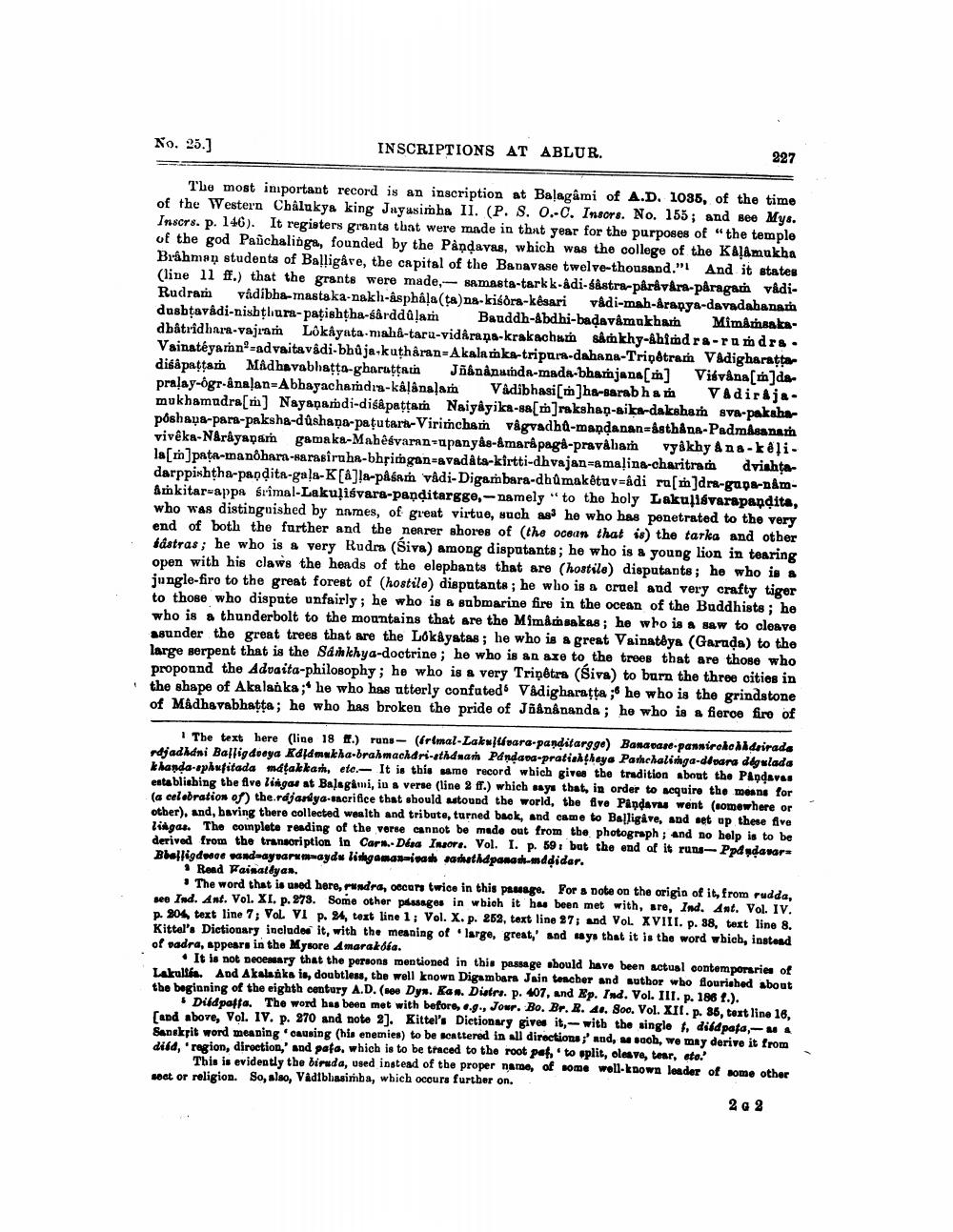________________
Xo. 25.)
INSCRIPTIONS AT ABLUR.
227
The most important record is an inscription at Balagâmi of A.D. 1085, of the time of the Western Châlukya king Jayasimha II. (P. S. 0.-C. Insors. No. 155; and see Mys. Inscrs. p. 146). It registers grants that were made in that year for the purposes of "the temple of the god Panchalinga, founded by the Påndayas, which was the college of the Kaļamukha Brahman students of Balligare, the capital of the Banavase twelve-thousand."! And it states (line 11 ff.) that the grants were made.- Bamasta-tarkk-adi-sastra-parkvara-paragamn vådiRudram vadibha-mastaka-nakh-asphala (ta)na-kisdra-kêsari v&di-mah-aranya-davadahanam dusbțavadi-nishthura-patishtha-sârddalam Bauddh-abdhi-badavamakham Mimárnsakadbâtridbara-vajram Lokayata mahd-taru-vidårana-krakachath sát khy-Ahindra-randra. Vainatéyarino-advaitavadi-bhů ja-kutharan-Akalamka-tripura-dahana-Tripdtram Vådigharata disapattam Madhavabhatta-gharutan Jñananuunda-mada-bharjana [m] Vibvåna[m]dapralay-ogr-anaļan=Abhayachandra-kaļâna!am Vådibhasi[m]ha-barab har Vadiraja. mukhamudra[r] Nayanardi-disapattam Naiyayika-sa[m]rakshap-aika daksham sva-paksha pôshana-para-paksha-dushand-patutark-Virimchaṁ vâgvadha-mandanan=&sthÅna-Padmasanam vivêka-Narayapam gamaka-Mahêśvaran-apanyâs-&marê paga-praváham vyakhy & ns-kêļi. la[m]paţa-manôhara-sarasiruha-bhşimgan=avadâta-kirtti-dhvajan-amaļina charitram dvishtadarppishtha-papdita-gala-K[&]!a-påsan vádi-Digambara-dhumaketu v=adi ru[m]dra-gapa-nimimkitar-appa srimal-Lakuļiśvara-panditargge, namely to the holy Lakulisvarapandita, who was distinguished by names, of great virtue, such as he who has penetrated to the very end of both the further and the nearer shores of the oceun that is) the tarka and other fástras; he who is a very Rudra (Siva) among disputants; he who is a young lion in tearing open with his claws the heads of the elephants that are (hostile) disputants; he who is a jungle-fire to the great forest of (hostile) disputants ; he who is a cruel and very crafty tiger to those who dispute unfairly; he who is a submarine fire in the ocean of the Buddhists ; he who is a thunderbolt to the mountains that are the Mimå sakas; he who is a saw to cleave asunder the great trees that are the Lokayatas; he who is a great Vainatêya (Garada) to the large serpent that is the Sainkhya-doctrine; he who is an axe to the trees that are those who propound the Advaita-philosophy; he who is a very Triņ@tra (Siva) to burn the three cities in the shape of Akalanka;' he who has utterly confuteds Vådigharaţta ;6 he who is the grindstone of Madhavabhatta; he who has broken the pride of Jianananda; he who is a fieroe fire of
1 The text here (line 18 fr.) runs- (frimal-Lakuiluara panditarggo) Bananase-panninckchadeirada adjadhani Ballig dveya Kalamukha-brahmachari-sthdnan Pandana-pratishthaya Panchalinga-dipara degulada khanda-sphufitada metakkan, eto.- It is this same record which gives the tradition about the Pandavas establishing the five lisgau at Balagâmi, in a verse (line 2 ff.) which says that, in order to acquire the means for (a celebration of the.rdjaniya-sacrifice that should astound the world, the five Pandavus went (nomewhere or other), and, baving there collected wealth and tribute, turned back, and came to Balligáve, and set up these five Lingas. The complete reading of the verse cannot be made out from the photograph; and no help is to be derived from the transcription in Car... Désa Indort. Vol. I. p. 59 but the end of it runs-Ppd ndarar Bbelligdage sand-ayvarummaydu lingamasivat saad panamddidar.
• Read Fainatdyan.
The word that is used here, rundra, occor twice in this pausge. For a note on the origin of it, from rudda, see Ind. Ant. Vol. XI. p. 273. Some other passages in which it has been met with, are, Ind. Ant. Vol. IV. p. 204, text line 7, VoL VI p. 24, text line 1; Vol. X. p. 262, text line 87; and Vol XVIII. p. 38, text line 8. Kittel's Dictionary included it, with the meaning of large, great,' and says that it is the word wbicb, instead of padra, appears in the Mysore Amarakóra.
• It is not necessary that the persons mentioned in this passage should have been actual contemporaries of Lakulife. And Akalaika is, doubtless, the well known Digambars Jain teacher and suthor who flourished about the beginning of the eighth century A.D. (see Dyn. Kan. Distro. p. 407, and Ep. Ind. Vol. III. p. 186 1.).
• Dildpaffa. The word has been met with before, .g., Jour. B. Br. R. 41. Soo. Vol. XII. p. 36, text line 18, rapd above, Vol. IV. p. 870 and noto 2). Kittel's Dictionary give it, with the single f. dildpafa,-MA Sanskrit word meaning causing (his enemies) to be scattered in all directions; and, asooh, we may derive it from disa, region, direction, and pafa, which is to be traced to the root patto split, oleave, tear, ato.
This is evidently the biruda, used instead of the proper name, of some well-known leader of some other soat or religion. So, also, Vaalbhasimba, which occurs further on. .
2 a 2




